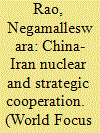| Srl | Item |
| 1 |
ID:
142726


|
|
|
|
|
| Summary/Abstract |
Elevation of China-Iran nuclear cooperation is a factor which pushed both countries’ willingness to improve strategic and military cooperation. Iran’s nuclear programme can be traced to the Shah’s rule, in the initial years of the Islamic Republic. At this time Iran had made significant advances in nuclear technology. Eventually Iran focussed on nuclear technology and this caused Iran to seek help from China. In fact, Iraq was also trying to develop nuclear weapons at that time. Hence Iran had sought help from nuclear advanced countries along with India for building a research reactor, while this was utilised effectively by China and provided other assistance in nuclear research. The Iran-Iraq conflict was one of the reasons behind Iran’s ambition to become a nuclear power and to be independent in enriching uranium. China helped Iran’s nuclear programme in return for benefits relating to access to Iran’s energy resources. China had, along with Russia, assisted Iran’s nuclear programme for peaceful use of nuclear energy and also provided it with material and training support. However dual use technology transferred from China to Iran may have been used for nuclear weapons technology.
|
|
|
|
|
|
|
|
|
|
|
|
|
|
|
|
| 2 |
ID:
142725


|
|
|
|
|
| Summary/Abstract |
The Central Asia had been the centre stage of imperial rivalry between Britain and Russia during the nineteenth century. Though changed in its dimension, the centrality of Central Asia did not diminish even inthe era of New Great Game. The geopolitical realities of the region changed with disintegration of Soviet Unionas well as with the emergence of fiveCentral Asian states, Kazakhstan, Kyrgyzstan, Tajikistan, Turkmenistan and Uzbekistanin the world politics. There are three factors which bring significance to the Central Asian states in theInternational Politics. Geographical location of the region is the first factor which has accrued significance to the region. It is a landlocked area with no access to the Oceans, and thus it needs welldeveloped land routes to access other countries. The second factor is its closeness to the important world powers such as Russia and China. And thirdly these States are rich inenergy resources such as natural gas and oil which gives it an important position in the issues of world politics. All these factors play a significant role indirecting the new phase of the Great Game towards Central Asia.
|
|
|
|
|
|
|
|
|
|
|
|
|
|
|
|
| 3 |
ID:
173534


|
|
|
|
|
| Summary/Abstract |
Almost every country in the world now is influenced by the social, economic and political consequences of oil production and its crises and India is also not spared from this. The cut-off of oil production by the OPEC (Organization of Petroleum Exporting Countries) countries have some serious concerns for a country like India as it is still in the process of its development.
|
|
|
|
|
|
|
|
|
|
|
|
|
|
|
|
| 4 |
ID:
163694


|
|
|
|
|
| Summary/Abstract |
Between 1961 and 1972, Latin America came to capture India’s diplomatic imagination. Officials within India’s Ministry of External Affairs identified strengthened ties with the region as a way to augment, restrain, and transcend the Non-Aligned Movement, further India’s international prestige and political influence, spread Indian culture, and bolster India’s economy. India’s interest in Latin America climaxed after Prime Minister Indira Gandhi prioritised the region and Pakistan strengthened diplomatic relations with Panama in autmn 1967. Yet uncertainty over the internal realities of Latin America hindered any Indian pivot. In the end, India’s aspirations for Latin America failed to materialise.
|
|
|
|
|
|
|
|
|
|
|
|
|
|
|
|